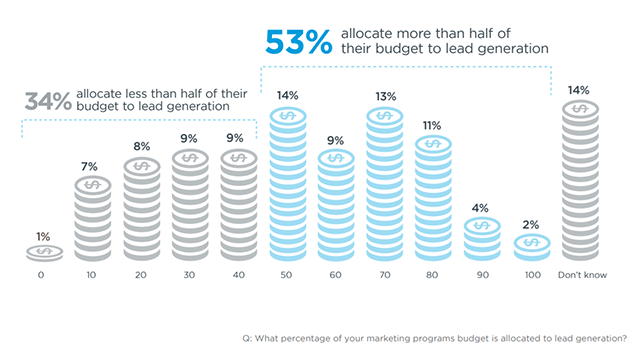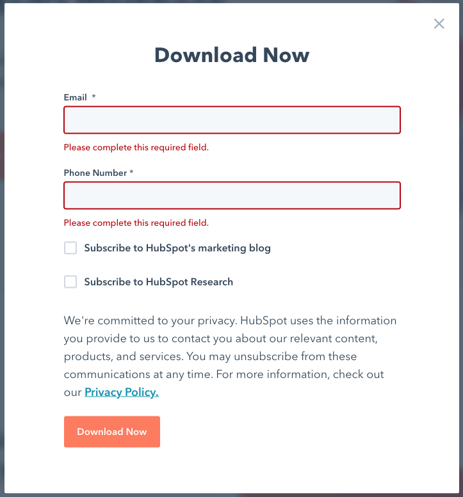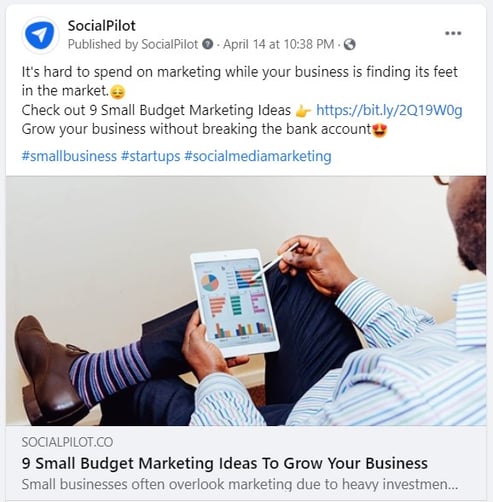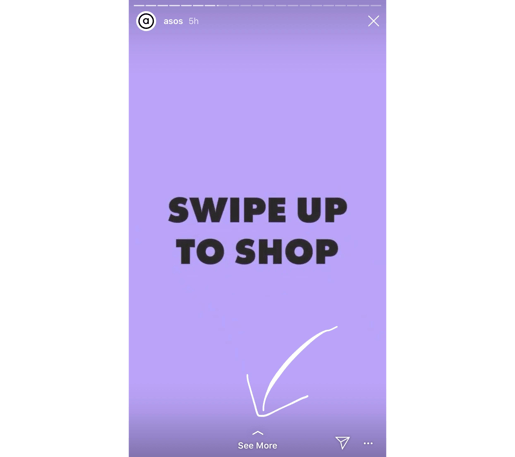Today we’re talking all things inbound lead generation for B2B businesses. Why? Well, here at the 'Hood, we know that 53% of marketers spend half (or more) of their budget on lead generation initiatives … so quite frankly, it'd be rude not to offer some advice.
As a B2B business owner or marketing manager overseeing your company’s lead generation marketing, how can you go about attracting more quality leads to your website? Mmm... full of great questions today I see!
The answer lies not with whistles and banners but with customer-centricity. Now, what exactly do we mean by that? Customer centricity simply means making sure your business provides the right answers to the right customers at the right moment in time.
That is the key to attracting quality prospects and converting visitors into leads (quality leads might we add).
Success lies in the strategy. By the end of this post, you’ll be in the secret circle and privy to all of our top B2B inbound lead generation secrets.
But don’t stress, you won’t have to sign a non-disclosure agreement or to read on to cop this comprehensive guide. Here at Neighbourhood, we're just a generous bunch of knowledge sharers.
TL;DR
- What is B2B inbound lead generation?
- The process behind the methodology
- B2B inbound lead generation strategies
- How to qualify a lead and convert
So, without further ado, let’s get into it!
What is B2B inbound lead generation?
I know, I know, you want to delve right into the juicy details but hold your horses for just a sec. It’s time to take a step back and revisit the basic foundations of lead generation.
Don’t run before you can walk and all that jazz.
Before we talk strategy, let’s define exactly what we mean by B2B inbound lead generation.
Lead generation is the term used to describe any method by which a business builds interest in their products and services.
‘Interest’ could mean anything from customers signing up to the company newspaper all the way to making a final purchase.
In fact, ‘lead’ is really just the overall term to describe any contact made with a potential customer. The ultimate lead generator is basically the Pied Piper of marketing.
In reality, leads can come in all sorts of different shapes and sizes and there are four main types that every B2B marketer should be aware of.
Lead type #1 - Marketing qualified lead (MQL)
A marketing qualified lead is any contact who has engaged with your marketing materials but isn’t ready to receive a sales call. They’re still a bit shy, so give them time.
Go in too strong and you’ll spook them!
Lead type #2 - Sales qualified lead (SQL)
A sales qualified lead is any contact who has actively demonstrated interest and purchase intent in your products or services. For example, Sue from Adelaide who placed your super snazzy sweater in her shopping basket but hasn’t committed to a purchase yet
Lead type #3 - Product qualified lead (PQL)
A product qualified lead is any contact who has taken part in a product or service demo and indicated purchase intent. They’re smart cookies. The PQL always does their research, so they’re not to be messed with! You’ll have to prove your worth with some valuable content.
Lead type #4 - Service qualified lead (SQL)
A service qualified lead is any contact who has indicated to a customer service representative that they are interested in becoming a paying customer. Your SQLs are precious, precious gold. Hold them close and don’t let go!

The process behind the methodology
Inbound lead generation is all about letting the customer initiate a relationship with you organically. Now, that doesn’t mean no pesticides (although we’re all for organic veggies too). An organic lead simply means that your prospects are people who are actively searching for a product or service, usually via an internet search engine. Because of this, inbound lead generation tends to be better for generating long-term customer investment in your brand as opposed to short term sales.
So, what’s the process behind this principle?
Well, it’s as easy as one, two, three…four.
Step 1: Discovery
Step one is the discovery step. This is when your prospects discover your brand’s hidden treasure. When a prospect first encounters your brand via one of its marketing channels, they enter the magical wonderland that is the first step in the inbound lead generation journey.
Step 2: Click
Step two is the click. Hopefully your marketing content has a killer CTA (call-to-action) backed by relevant content. A CTA encourages users to take action, usually via a button or message. Make your CTA irresistible enough and your prospects will click without a second thought.
Step 3: Capture
Once a prospect has clicked on your CTA it will take them to your chosen destination (typically that’s your website landing page). This is where you get your metaphorical net out and capture those leads and their contact information.
A great way to do this is to provide an offer in exchange. For example, you might entice customers with an eBook, free course that, in return, they must sign up for with their contact information.

Step 4: Form
Last but not least, suitably enticed by your marketing charms, your prospect will be happy to fill out a form in exchange for that dreamy offer. And that leaves you with a brand-spanking-new, fully organic, lead. You never know, they might just become your most loyal customer.
Top B2B inbound lead generation strategies
Congratulations! You’ve graduated to the school of inbound lead generation strategies. We’ve covered the basics and now we think you’re ready for our classified secrets.
We’re going to show you how to develop a killer B2B lead generation strategy of your own. The magic ingredient is communication and the second magic ingredient is variety. You’ll want to utilise a wide range of these lead generation methods to make your marketing efforts worth it.
So, cast your fishing net wide and reap the bounties of the sea (or, in this case, the internet).
Strategy #1 - Ramp up your content marketing with the best blog on the block
Did you know that content marketing generates up to three times more leads than traditional marketing methods?
Content marketing is one of the most effective ways to attract people to your website. Having a plethora of quality (and SEO optimized) content for prospects to peruse will guide visitors from the search engine to your landing page. If your content offers value then you’ll be sure to convert some of the visitors into paying customers.
Plus, content is the ideal platform for extending your branding initiatives. As well as providing potential leads with information, content communicates your brand ethos, values, and personality. When customers align with that ethos, value, and/or personality, it’s a recipe for longevity and a fulfilling customer experience.
So, whether you’re serious and factual, informative but casual, or super laissez-faire, make sure your content shows your customers exactly who you are.
We recommend starting with your business blog. If you’ve not already got a brand blog then that’s a great place to start. You don’t need to be the next Jane Austin or J.K. Rowling. Your blog should just be a place for value-packed, informative content that reflects who you are as a company.
Top types of content to try out include:
- Authoritative posts
- Opinion pieces
- Industry research
- How-to guides
- Infographics
- Video content
- Trending topics
Blog posts are also great places to use promotional offers for conversion opportunities. The beauty of a blog post is that you can craft your content to support whatever end goal you have in mind. For example, if you’re selling CRM software to e-commerce businesses then writing blog materials about CRM benefits, use-cases, or even providing real-life case studies, is likely to be considered highly valuable by your prospects.
At the end of your blog post make it super easy for your readers to navigate to your landing page, sales page, resources, or offers via an engaging CTA.
Blogging will:
- Drive more traffic to your website
- Convert that traffic into leads via CTAs
- Encourage repeat business and referrals
Strategy #2 - Lap up those social media conversion rates
Social media, love it or hate it, is a boon for marketers. So, it’s time to put any strong feelings about this medium aside, and use this highly effective lead generation tool to your advantage.
If Facebook makes your blood boil…well…tough. You can recover later with a nice bubble bath. But, for now, it’s a sacrifice you’re going to want to make for the greater good of your business.
Social media is fantastic for building brand awareness. But that’s not all.
Oh no.
Increasingly, B2B marketers are using social media platforms to turn prospects into leads by guiding them towards desired actions through clever CTAs, moving them along that all important buyer journey.
Social media makes it easy to be creative with your calls-to-action.

You can choose the classic CTA button at the end of a post, or you can mix things up a bit with LinkedIn Ads, Instagram stories, Facebook lives, or reels. In so much as a swipe, your prospects can be redirected to your landing page.

The best CTAs spark enthusiasm by presenting a challenge, creating a sense of urgency, asking controversial questions, inciting pop culture, sparking conversation, or just being downright hilarious.
The top social media platforms for B2B businesses are LinkedIn and Facebook.
- LinkedIn Ads is perfect for audience targeting, providing newsworthy and topical Ads, and for testing out new CTAs, social media posts, and brand images.
- Facebook Lead Ads allow B2B users to sign up for offers in a click without ever having to leave the platform. That means your prospects will be able to sign up to mailing lists and offers directly from their social media account.
Strategy #3 - Show them how it's done with product demos
One of the biggest struggles for B2B businesses is finding ways to help buyers feel confident in purchasing their products. Buyers will be grateful for any kind of ‘try before you buy’ option. And that’s where product demos come in.
Demos are particularly useful for talking prospects through a software product or service. It will give your potential buyer the opportunity to see exactly what it is they are investing their money in. A fantastic, accurate, and enticing product demo is a sure way to gain qualified sales leads.
Strategy #4 - Invest in success with pay-per-click (PPC)
Why pay for advertising space when I can get it for free?
I hear you. I really do. But hear us out. PPC is likely to give more than it takes away. It’s generous like that, you see.
Let’s talk about PPC (that’s pay-per-click between you n’ me). PPC advertising is essentially paid advertising space. PPC allows businesses to target prospects with much more precision by selling prime ad space across top advertising platforms like GoogleAds, Microsoft Ads, AdRoll, and more.
Think of it like billboards for the virtual world of the internet. Instead of plastering a 40ft. poster on the highway, PPC allows you to paste your ad in prime search engine territory.
So much more convenient!
Every time a prospect clicks on your ad, you’ll incur a small fee from the advertising platform. Typically, revenues generated from PPC far outweigh any incurred expenses. In fact, for every $1 spent on Google AdWords, businesses earn back an average revenue of $2.
PPC makes for a great complement to your organic content marketing, but that doesn’t mean it should replace organic marketing methods entirely.
It’s all about finding the balance.
Combine the two and you’ve got a match made in heaven!
Strategy #5 - Old school email marketing knows best
Email may have been around since the Stone Age (well, maybe not quite that long) but it’s a tried, tested, and proven inbound lead generator that works.
I mean, really works.
89% of marketers still use email as their primary lead generation channel. And it’s not just because they’re stuck in their ways. Email has lasted because it’s, well, simply the best, better than all the rest! Email really is made for B2B marketing. Since B2B businesses market to other professionals, it’s encouraging to know that 86% of professionals prioritize email connections.
So, why is email so damn good at its job?
Well, there’s a few reasons.
First, the people on your emailing lists will already have shown active interest in your brand by subscribing or ‘opting-in’ to email correspondence from your company, giving you some pretty important contact info in the process to nurture those leads. That’s a positive indication that they are more likely to have real purchase intent. They are already familiar with your product or service and may only need a little CTA-shaped nudge to take action and buy.
So, what can you do to improve your email marketing conversion rates?
Email may be good, but it needs to be nurtured and sculpted if you want to see amazing results.
The best email marketing campaigns have a few things in common:
- They always use concise personalised subject lines
- They entice prospects with value offers
- They include catchy CTAs linking prospects to a relevant landing page
- They segment mailing lists so that targeted messages reach the right individuals
- They use marketing analytics to optimize their mailing lists and email content
Strategy #6 - If it didn't work the first time, try and try again
Now, I’m not telling you to barrage your mailing lists with the same emails time and time again. Unless you actually want to drive them away that is.
But giving up when a promising lead falls through isn’t the answer either.
The solution lies in something called retargeting. Even the best archer doesn’t always hit the bullseye first time around.
Retargeting is all about going in from another angle and getting the best shot.
Retargeting ads offer B2B businesses a way to re-engage customers who have shown interest but failed to convert for one reason or another. Perhaps they’ve read your content, watched your videos, signed up for your eBook, but then dropped off the face of the planet completely.
Sound familiar?
This is a very common phenomenon. A retargeting ad will remind your prospect of what they’re missing and redirect them back to your website where (fingers crossed) they will complete on that sale.
Strategy #7 - Referrals: the top B2B lead generator
B2B lead generation is its own beast. It’s not a mirror image of business-to-consumer (B2C) marketing. Because B2B businesses are directing their marketing campaigns towards other industry professionals, it’s important to provide prospects with the right type of impetus.
And for business professionals, referrals remain one of the most trusted sources of information. Referrals remain a top source for business leads. In this ecosystem, recommendations reign supreme.
That means one of the best things you can do as a B2B business owner or marketing manager is to build up a large network of customer Allum and brand ambassadors that are willing to advocate for your product or service.
But why do recommendations carry so much weight?
Well, businesses respect the opinions of other successful businesses. It’s as simple as that. Plus, if an organisation is planning to invest in an expensive product then they’re going to want to reduce as much risk as possible. Knowing that another organisation has seen success from using said product or service will encourage them to follow suit.
So, whatever you do, make sure your B2B inbound lead generation strategy includes a healthy dose of referral marketing. If you don’t already have a huge network of referees, don’t sweat it. There are many ways you can build up a repertoire of referees. Below we’ve listed a few of the very best.
- Make it easy as pie – make it easy for past customers to leave recommendations (e.g., on your website or social media channels).
- Don’t be afraid to ask – reach out and ask past and loyal customers to make a referral.
- Reward referees with an incentive – e.g., 10% discount for those who refer a friend
- Consider partnering with online influencers within your industry
How to qualify a lead and convert
Alrighty!
You know everything you need to know about B2B inbound lead generation. You’re pretty much a bona fide lead-gen guru!
So, once you’ve generated tons of high-quality leads, what next?
Don’t just leave your prospects hanging. Get converting! Once somebody has shown you that they are interested in your product or service, it’s time to cultivate that relationship even further. Woo them, schmooze them, and send them the most thrilling emails of their god damn lives! Use all that valuable content you've garnered and share it with them.
Offer your top leads additional support in the form of offers, exclusive content, and exceptional support.
Ready, set, generate!
You’re all ready to go out there and generate some tip-top quality leads. As a B2B business owner or lead generation marketing exec, chances are you’re always on the look out for ways to reach out to more potential customers. Remember, communication and variety are key to success.
Employing a wide range of lead generation strategies will always stand you in good stead. Whatever methods you choose to include in your inbound lead generation strategy, make sure that referrals are one of them. Businesses trust other businesses when making big-money purchases. So don’t lose out on the power of a cracking recommendation!
Here at Neighbourhood, it’s our mission to help organisations like yours find, sell, and keep their people online with better business branding, sales, and marketing. Chat with us today to see or schedule a catch up in your own time to see what Neighbourhood could do for your company.


